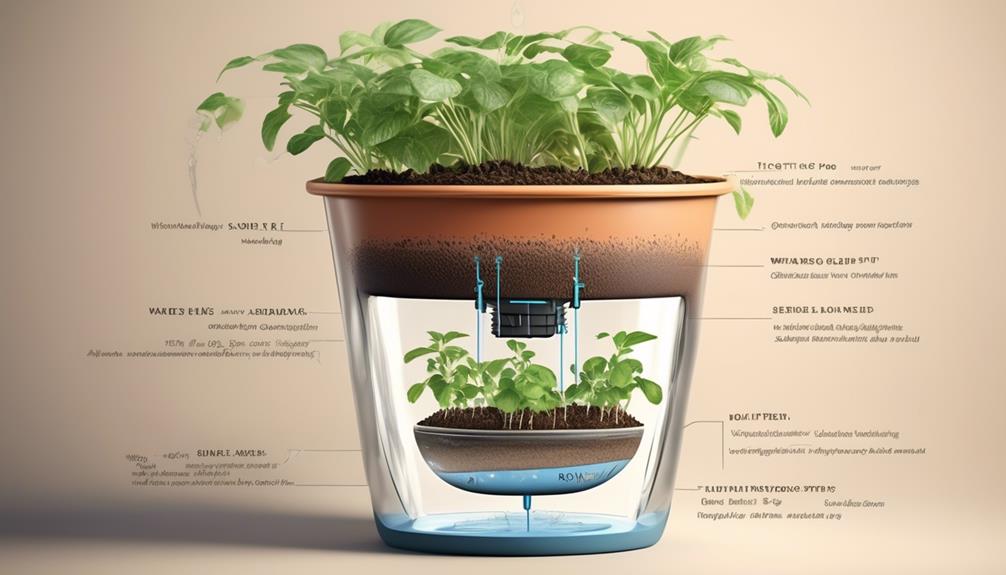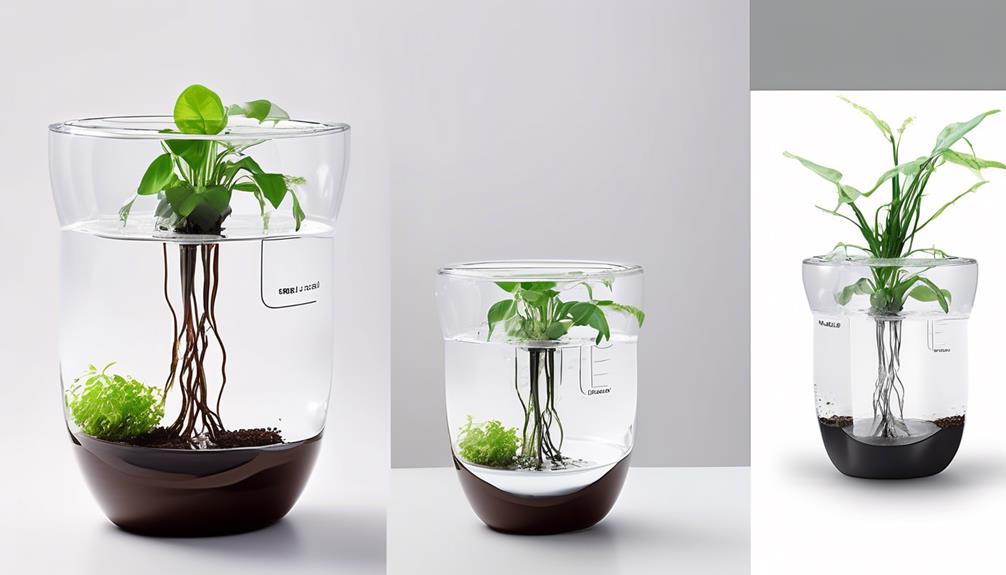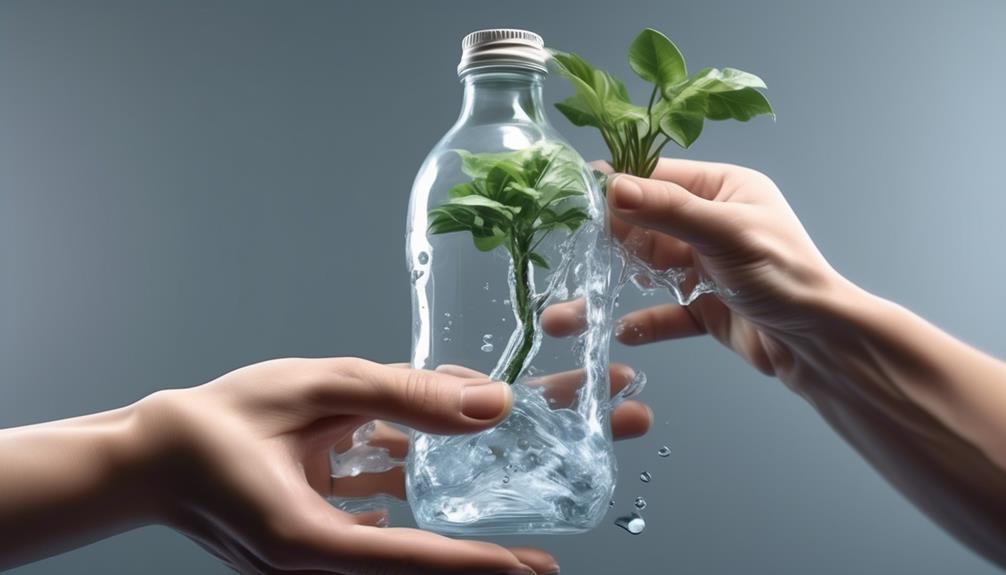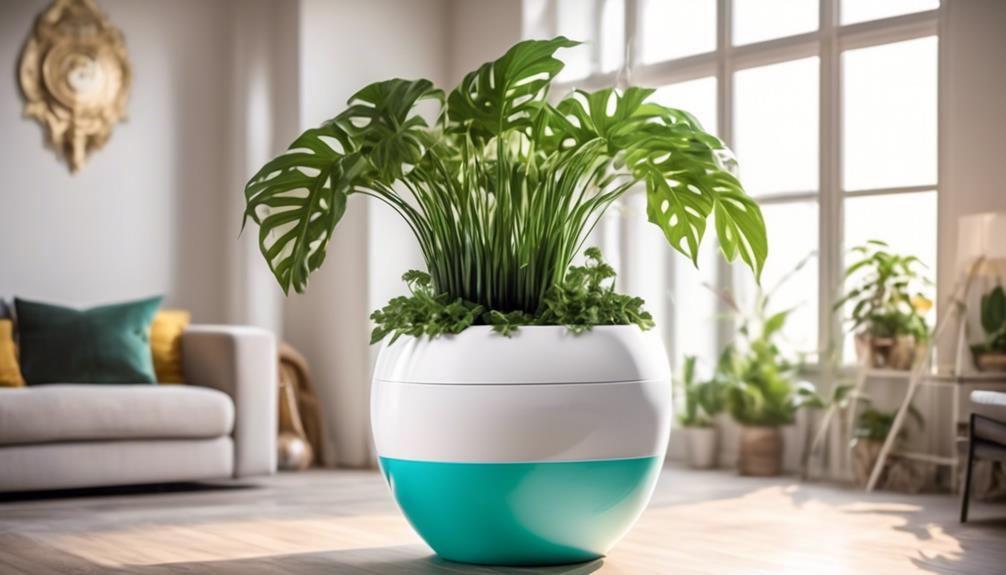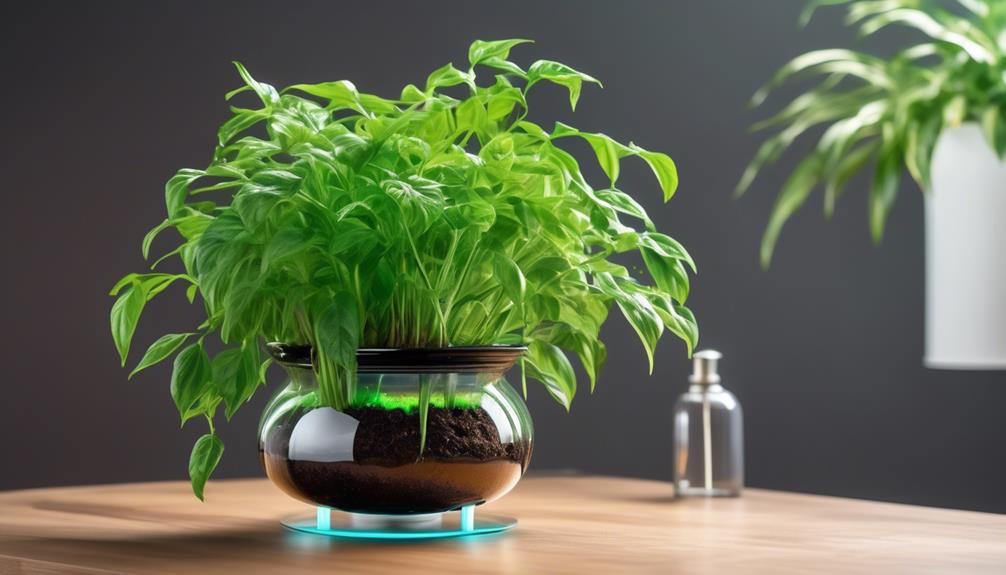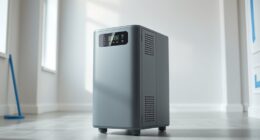In our efforts to keep our plants healthy and thriving, we are always looking for practical solutions that fit seamlessly into our daily routines. This is where square self-watering planters come in. These innovative planters offer a simple way to ensure your plants stay hydrated, removing the need for frequent watering.
But there's more to it than just the convenience factor. As we explore the benefits and practical tips for using these pots, you'll discover how they can elevate your gardening experience in unexpected ways.
So, if you're curious about how to take your plant care to the next level, we've got some insightful information to share.
Key Takeaways
- Efficient use of space and water
- Self-watering system provides consistent moisture to plant roots
- Reduces water wastage by delivering precise amount of water needed
- Material choice impacts durability, insulation, and aesthetic appeal
Benefits of Square Self-Watering Pots
When considering the benefits of square self-watering pots, it's important to note their efficient use of space and water, making them an ideal choice for urban or small-scale gardening.
The design of square self-watering pots allows for a more efficient use of space, as they can be placed closer together than traditional pots, maximizing the growing area.
Additionally, these pots have a self-watering system that provides a constant supply of moisture to the plants' roots, ensuring watering efficiency and promoting plant health.
From an environmental perspective, square self-watering pots contribute to water conservation.
The self-watering feature reduces water wastage by delivering the precise amount of water needed by the plants, minimizing runoff and evaporation.
This not only benefits the plants but also has a positive environmental impact by conserving water resources.
Choosing the Right Size and Material
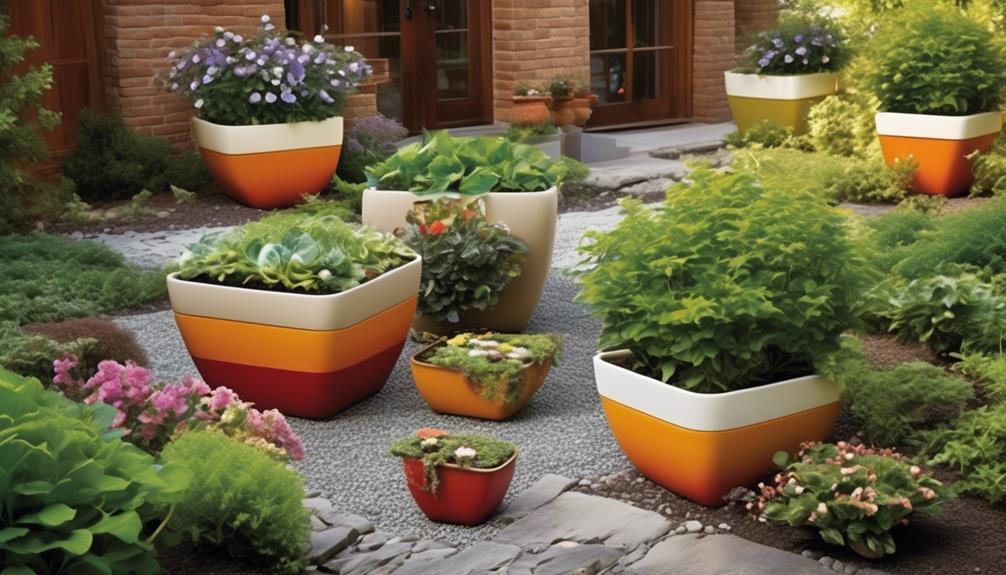
When choosing the right size and material for self-watering pots, it's important to consider the specific needs of the plants you'll be growing.
The size of the pot will determine the amount of soil and water it can hold, affecting the frequency of watering required.
Additionally, the material of the pot can impact its durability, insulation, and overall aesthetic appeal, making it crucial to select the most suitable option for your gardening needs.
Size Considerations
Selecting the appropriate size and material for self-watering pots is crucial for ensuring optimal plant health and growth.
When considering size options, it's important to match the pot to the specific needs of the plant. Larger pots can accommodate bigger plants and offer more space for root growth, while smaller pots are suitable for compact plants or those with shallower roots. The size of the pot also impacts watering frequency. Larger pots hold more soil and retain moisture longer, reducing the frequency of watering. Conversely, smaller pots dry out more quickly and may require more frequent watering.
Additionally, the material of the pot can influence moisture retention and durability. Porous materials like terracotta allow for better airflow and water evaporation, while plastic pots retain moisture more effectively.
Understanding these size and material considerations is essential for maintaining healthy plants in self-watering pots.
Material Options
Considering the size and material of self-watering pots is crucial for ensuring optimal plant health and growth, with the material options playing a significant role in moisture retention and durability.
When choosing the right material for square self-watering pots, it's essential to consider factors such as porosity, insulation, and longevity. Here's a comparison of common material options:
- Plastic: Affordable and lightweight, but may not offer the best insulation and can degrade over time.
- Ceramic: Provides excellent insulation, but can be heavy and prone to cracking if not handled carefully.
- Concrete: Offers superior durability and insulation, but can be heavy and may require additional sealing to prevent moisture loss.
Each material has its own benefits and drawbacks, so it's important to weigh these factors against the specific needs of the plants being grown.
How to Set Up Your Self-Watering Pot
Let's start by assembling the self-watering pot, ensuring all components fit together securely.
We'll then set up the water reservoir, making sure the wick or watering tube is properly installed to provide consistent moisture to the soil.
Assembling the Pot
To assemble your self-watering pot, begin by carefully placing the wick in the designated wick hole, ensuring it hangs down into the water reservoir.
Next, insert the water float valve into its designated slot, making sure it's secure and properly positioned.
Then, carefully place the potting mix into the planting basket, ensuring it's evenly distributed and level.
After that, gently place the planting basket into the pot, ensuring it sits securely on the ledge inside.
Finally, fill the water reservoir with water, allowing the wick to absorb the water and provide moisture to the plant's roots.
These steps ensure that your self-watering pot is assembled correctly, providing an optimal environment for your plants to thrive.
Water Reservoir Setup
The water reservoir setup for your self-watering pot involves positioning the water float valve in place and ensuring the wick is properly inserted into the designated wick hole. To ensure optimal functionality, it is crucial to set up the water reservoir correctly. We recommend following the steps outlined below to set up your self-watering pot.
| Step | Description |
|---|---|
| 1 | Position the water float valve in the designated area. |
| 2 | Insert the wick into the wick hole, ensuring it reaches the bottom of the pot. |
| 3 | Fill the reservoir through the designated opening until the water level reaches the fill line. |
| 4 | Place the potting mix in the top container, ensuring it makes contact with the wick. |
| 5 | Monitor the water level regularly to adjust watering frequency and prevent evaporation. |
Properly setting up the water reservoir ensures efficient self-watering functionality, reducing watering frequency and preventing evaporation.
Soil and Planting
After setting up the water reservoir for optimal functionality, the next step in setting up your self-watering pot is to prepare the soil and plant your desired greenery. Here's how to do it:
- Soil Composition: Use a well-draining soil mix that's specifically formulated for container gardening. A mix of peat moss, perlite, and vermiculite provides good aeration and moisture retention, which is crucial for self-watering pots.
- Planting Techniques: Create a small mound of soil in the center of the pot, ensuring it's at the same level as the top of the water reservoir. Gently remove the plant from its nursery container, loosen the root ball, and place it on top of the soil mound. Fill in the remaining space with soil mix, ensuring the plant is stable and upright.
Maintenance Tips for Long-Term Use
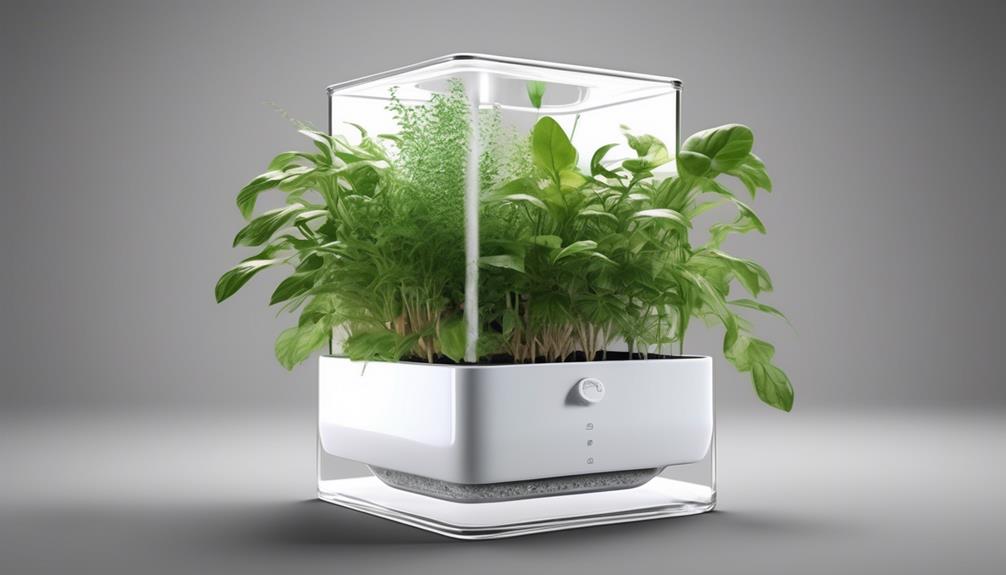
For optimal long-term use of self-watering pots, it is essential to adhere to a regular maintenance routine, ensuring the proper functioning of the watering system and the overall health of the plants. To maintain long term durability and ensure the health of your plants, it's important to follow these maintenance tips:
| Maintenance Task | Frequency | Notes |
|---|---|---|
| Check water reservoir | Weekly | Ensure it's filled to the appropriate level. |
| Clean watering system | Monthly | Remove any debris or mineral buildup to prevent clogging. |
| Inspect plant health | Bi-weekly | Look for signs of over or under-watering, adjust as needed. |
Regularly checking the water reservoir ensures that your plants have a consistent water supply, promoting healthy growth. Cleaning the watering system prevents blockages, maintaining proper water distribution. Inspecting plant health bi-weekly allows for timely adjustments to the watering frequency, ensuring optimal growing conditions.
Best Plants for Self-Watering Pots

When selecting plants for self-watering pots, it's important to consider their water requirements and adaptability to the watering system. The choice between indoor and outdoor plants and their drought tolerance is crucial for the success of the self-watering pots.
Here are some recommended plants for self-watering pots:
- Indoor Plants: Opt for indoor plants like pothos, snake plant, or peace lily for self-watering pots placed indoors. These plants thrive in the controlled environment of indoor spaces and have moderate water requirements, making them suitable for self-watering pots.
- Outdoor Plants: For outdoor self-watering pots, consider plants like petunias, marigolds, or succulents. These plants are well-suited for outdoor conditions and can withstand varying water levels, making them ideal choices for self-watering pots in outdoor settings.
- Drought-Tolerant Options: If you live in an area with water scarcity or wish to minimize water usage, consider plants like lavender, sedum, or yucca. These plants are drought-tolerant and can thrive with minimal water, making them excellent choices for self-watering pots designed for water conservation.
Carefully selecting plants based on their water requirements and adaptability to the self-watering system will ensure the health and vitality of your plants in self-watering pots.
Styling and Placement Ideas for Your Pots
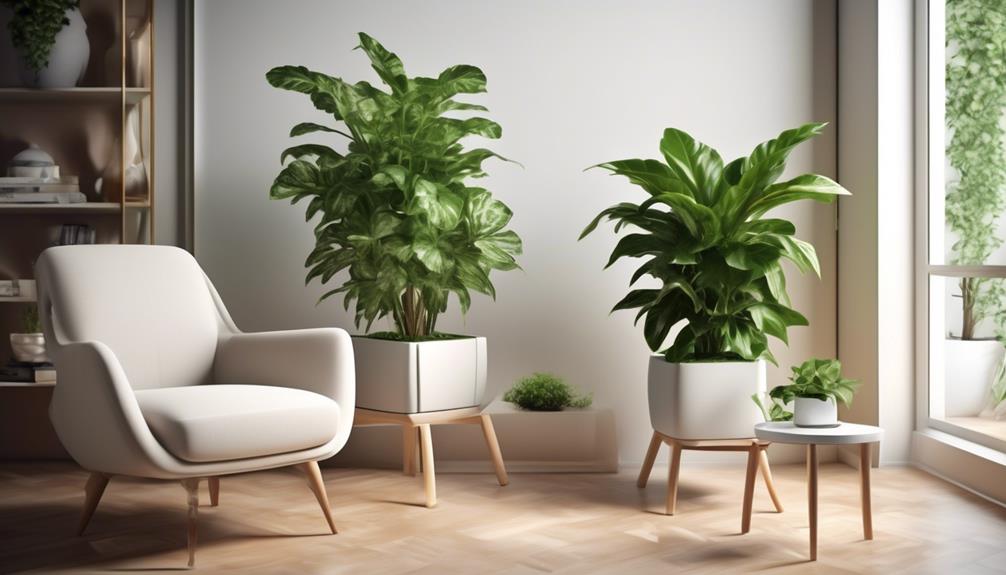
Considering the water requirements and adaptability of the selected plants, our focus now shifts to exploring optimal styling and placement ideas for maximizing the functionality and aesthetic appeal of your self-watering pots. When it comes to styling tips, it's essential to consider the overall design aesthetic of the space where the pots will be placed. For a modern and minimalistic look, sleek square self-watering pots in neutral colors like white or black can be paired with a variety of succulents or air plants. On the other hand, for a more vibrant and eclectic style, consider mixing different sizes and colors of self-watering pots and filling them with a mix of trailing vines, colorful flowers, and leafy greens.
| Styling Tips | Plant Pairing Ideas |
|---|---|
| Modern & Minimalistic | Succulents, Air Plants |
| Vibrant & Eclectic | Trailing Vines, Colorful Flowers, Leafy Greens |
Placement is equally important. Ensure that the pots are placed in areas that receive adequate sunlight for the chosen plants. Additionally, consider the visual impact of the arrangement, such as grouping pots of varying heights and sizes together to create visual interest. By carefully considering styling and placement, you can ensure that your self-watering pots not only provide the necessary care for your plants but also enhance the overall aesthetic of your space.
Frequently Asked Questions
Can Self-Watering Pots Be Used for Outdoor Plants as Well?
Yes, self-watering pots can be used for outdoor plants as well. Outdoor plant benefits include better water retention and reduced watering frequency. Watering efficiency is improved due to the self-watering system, which helps maintain optimal soil moisture levels. This is especially helpful for outdoor plants that may be exposed to varying weather conditions.
Are There Any Specific Soil Requirements for Using Self-Watering Pots?
When using self-watering pots, it's crucial to consider soil composition and watering frequency. The right soil mix ensures proper water distribution and root oxygenation, promoting plant health. A well-draining mix consisting of peat, perlite, and vermiculite is often recommended. This combination balances water retention and aeration.
Additionally, watering frequency depends on the plant type, pot size, and environmental conditions. Monitoring soil moisture levels helps determine the appropriate watering schedule for optimal growth.
Can Self-Watering Pots Be Used for Herbs or Vegetables?
Yes, self-watering pots can be used for herbs and vegetables.
When it comes to herb growth, the watering frequency is crucial for optimal development.
For vegetables, the pot size plays a critical role in determining the yield.
Understanding the specific water and space requirements for different herbs and vegetables is essential for successful cultivation in self-watering pots.
Mastering these nuances will result in thriving plants and bountiful harvests.
Are There Any Potential Drawbacks to Using Self-Watering Pots?
We've found that consistent moisture in self-watering pots can lead to potential mold growth. It's important to monitor the water level and ensure proper ventilation to prevent this issue.
Additionally, the design of self-watering pots may not be suitable for all plant types, as some plants may require a different watering schedule or soil structure.
Understanding these drawbacks can help in making informed decisions about using self-watering pots for gardening.
Can Self-Watering Pots Be Used in a Hydroponic Setup?
Yes, self-watering pots can be used in a hydroponic setup. Their hydroponic compatibility is due to their efficient watering system, which provides a consistent supply of water to the roots. This benefits plants by ensuring optimal hydration levels, promoting healthy growth.
The self-watering feature allows for precise control over water intake, reducing the risk of over or under-watering. This makes self-watering pots a valuable addition to hydroponic systems.
What are the benefits of using self-watering pots for square plants?
Self watering square pots offer several benefits for square plants. They provide a constant water supply, preventing overwatering or underwatering. The built-in reservoir reduces the frequency of watering, making it convenient for busy individuals. The pots also promote healthier root growth and overall plant growth, resulting in vibrant and lush square plants.
Conclusion
So, in conclusion, square self-watering pots offer a convenient and efficient way to keep your plants hydrated.
With their sleek design and practical functionality, these pots are a stylish addition to any indoor or outdoor space.
By taking the guesswork out of watering, these pots provide a low-maintenance solution for plant care.
Embracing the beauty of nature has never been easier with the use of these innovative self-watering pots.


